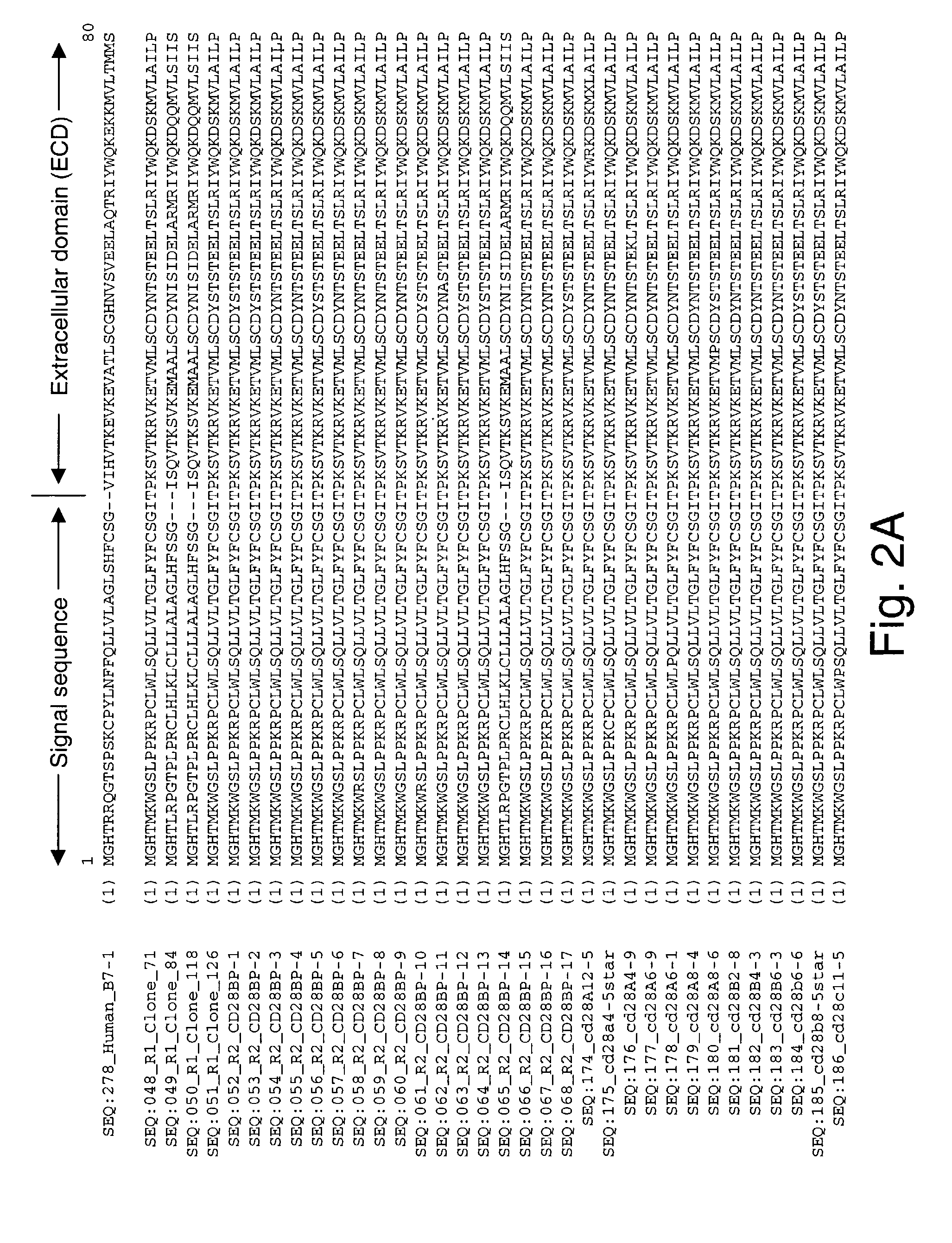Co-stimulatory polypeptides
a polypeptide and co-stimulator technology, applied in the field of polynucleotides and polypeptides, can solve the problems of t cell activation down-regulation, limited clinical application usefulness of b7-1 and b7-2 binding properties, etc., and achieve the effect of enhancing or limiting cytokine production
- Summary
- Abstract
- Description
- Claims
- Application Information
AI Technical Summary
Benefits of technology
Problems solved by technology
Method used
Image
Examples
examples
[0530]The following examples are offered to illustrate the present invention, but not to limit the spirit or scope of the present invention in any way.
Materials and Methods
A. Isolation of Mammalian Parental cDNAs for Library Construction.
[0531]Human, rhesus monkey, baboon, orangutan, cow (GenBank Acc. No. Y09950), cat, and rabbit (GenBank Acc. No. D49843) wild-type B7-1 (CD80) parental genes were cloned by the reverse transcriptase polymerase chain reaction (RT-PCR) method. RAJI, PUTI, LCL8664, and 26CB-1 cell lines were used as sources of total or messenger RNA (mRNA) for human (Homo sapiens), orangutan (Pongo pygmaeous), rhesus monkey (Macaca mulatta)(GenBank Acc. No. U19840) and baboon (Papio hamadryas) B7-1 genes for B7-1 cDNA preparation. mRNA or total RNA encoding feline (Felis catus), bovine (Bos taurus) and rabbit (Oryctolagus cuniculus sub-species domesticus) B7-1 genes for B7-1 cDNA preparation were obtained from peripheral blood mononuclear cells (PBMCs) derived from the ...
example i
Cloning of Parent cDNA Sequences for Library Construction
[0553]The cDNAs encoding human, rhesus monkey, orangutan, baboon, bovine, rabbit, and feline B7-1 (CD80) co-stimulatory molecules were cloned by RT-PCR. These starting B7-1 genes encoded polypeptide molecules with, by comparison, amino acid sequence identities ranging from about 58–98% amino acid sequence identity using Jotun Hein method, DNASTAR (in MegaLine™ DNASTAR package, MegaLine™ Ver. 4.03), following manufacturer's instructions and using default values specified in the program. The polynucleotide sequences for baboon B7-1 (SEQ ID NO:46) and orangutan B7-1 (SEQ ID NO:47) are examples of WT NCSM polynucleotides whose sequences were previously unknown. These baboon B7-1 and orangutan B7-1 polynucleotides, as well as homologues and baboon B7-1 (SEQ ID NO:93) and orangutan B7-1 (SEQ ID NO:94) polypeptides encoded therefrom, are included as NCSM molecules of the invention.
[0554]The RAJI, PUTI, LCL8664, and 26CB-1 cell lines ...
example ii
Preparation and Screening of Round I NCSM Libraries
[0556]Nucleic acid libraries comprising recombinant nucleic acid sequences were generated by using the seven cloned cDNA wild-type CD80 nucleic acid sequences as parental sequences and applying recursive sequence recombination methods as described above to such sequences. In one aspect, libraries comprising chimeric nucleic acid sequences were generated by applying DNA shuffling procedures to the seven mammalian cDNA sequences as described previously in, e.g., Stemmer, W. (1994) Nature 370:389–391 (1994) and Crameri, A. et al. (1998) Nature 391:288–91, each of which is incorporated herein by reference in its entirety for all purposes. Sequencing of randomly selected chimeric clones a recombinant library indicated that 12 out of 12 clones comprised nucleotide fragments from at least two of the starting genes, illustrating efficient chimerism.
[0557]Initial screening of the resulting chimeric NCSM clones was based on binding assays in ...
PUM
| Property | Measurement | Unit |
|---|---|---|
| Fraction | aaaaa | aaaaa |
| Fraction | aaaaa | aaaaa |
| Fraction | aaaaa | aaaaa |
Abstract
Description
Claims
Application Information
 Login to View More
Login to View More - R&D
- Intellectual Property
- Life Sciences
- Materials
- Tech Scout
- Unparalleled Data Quality
- Higher Quality Content
- 60% Fewer Hallucinations
Browse by: Latest US Patents, China's latest patents, Technical Efficacy Thesaurus, Application Domain, Technology Topic, Popular Technical Reports.
© 2025 PatSnap. All rights reserved.Legal|Privacy policy|Modern Slavery Act Transparency Statement|Sitemap|About US| Contact US: help@patsnap.com



